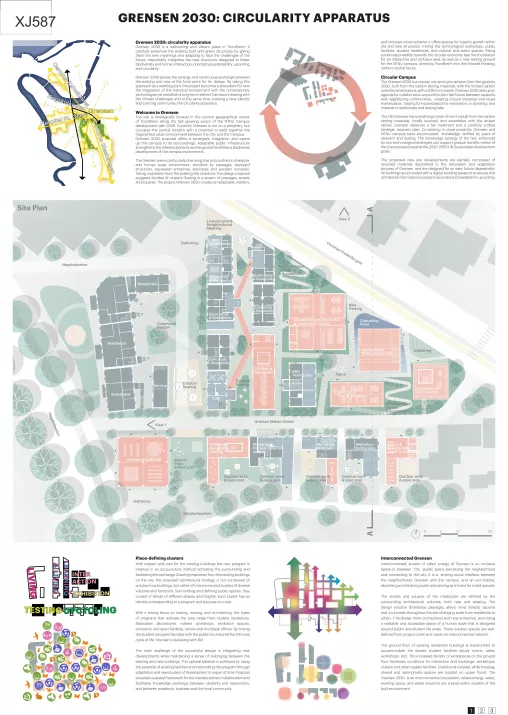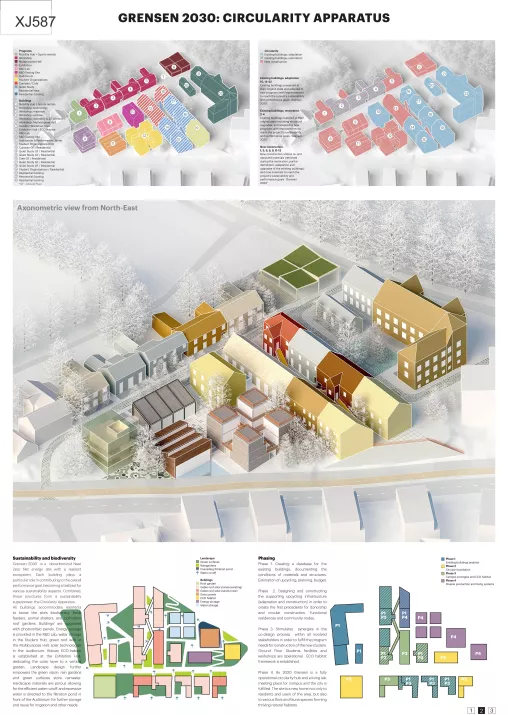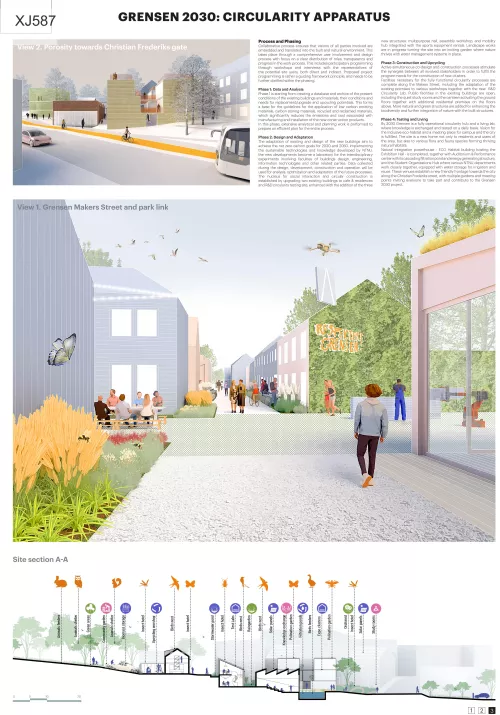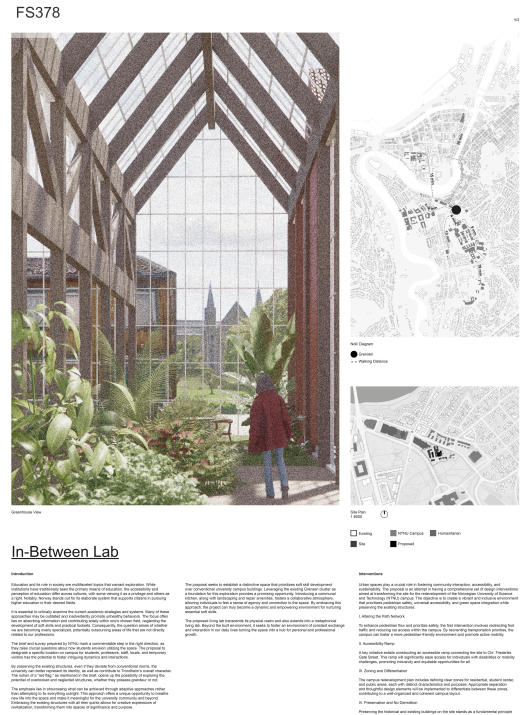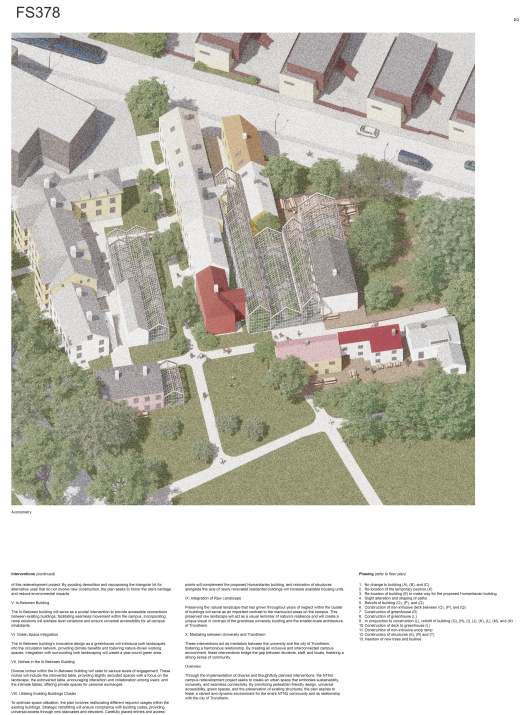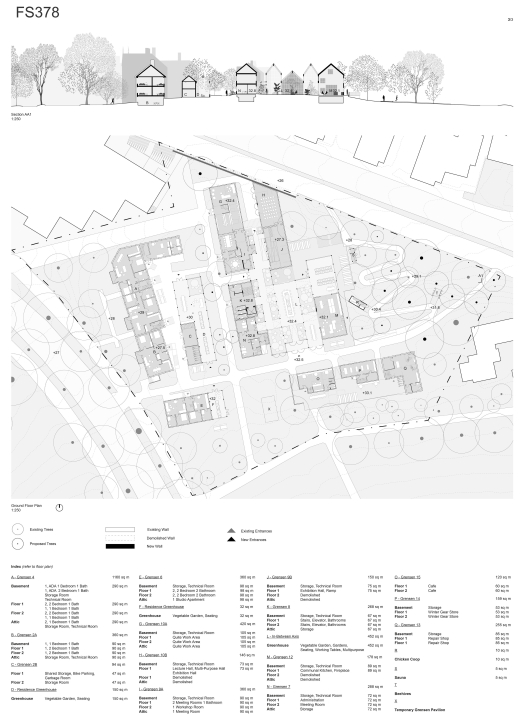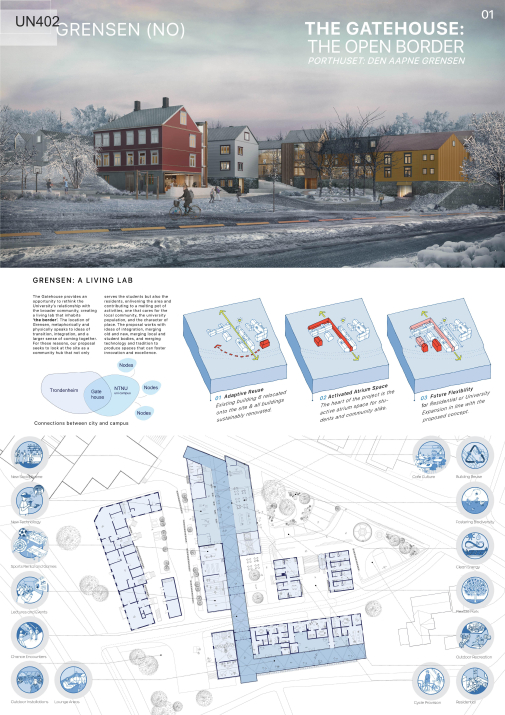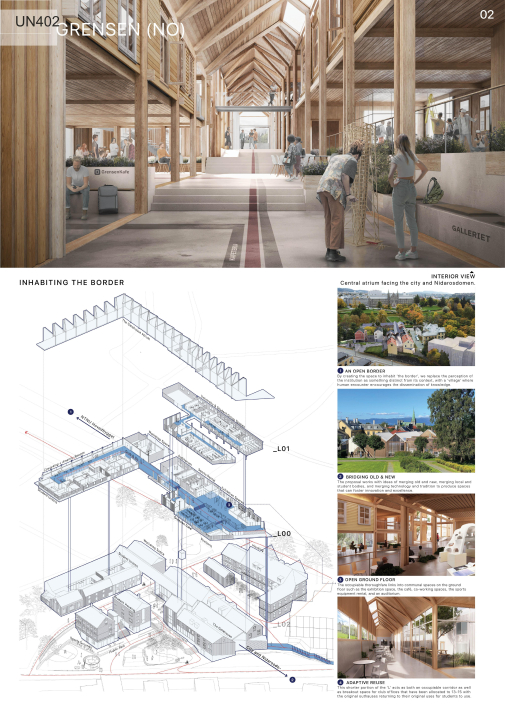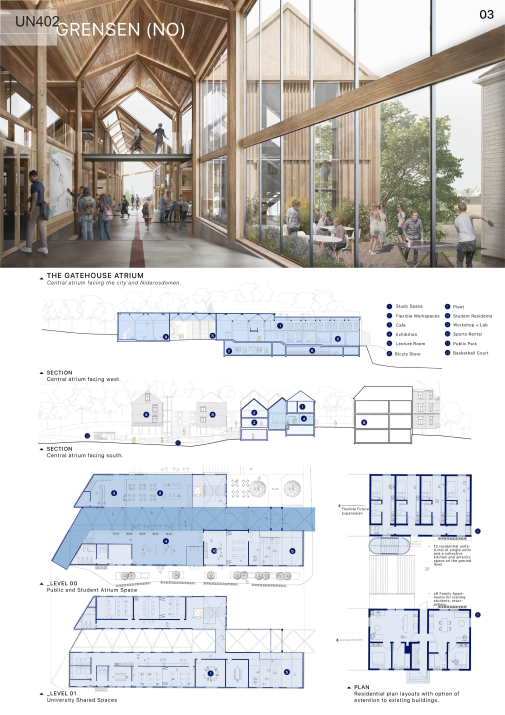The results for Grensen are here
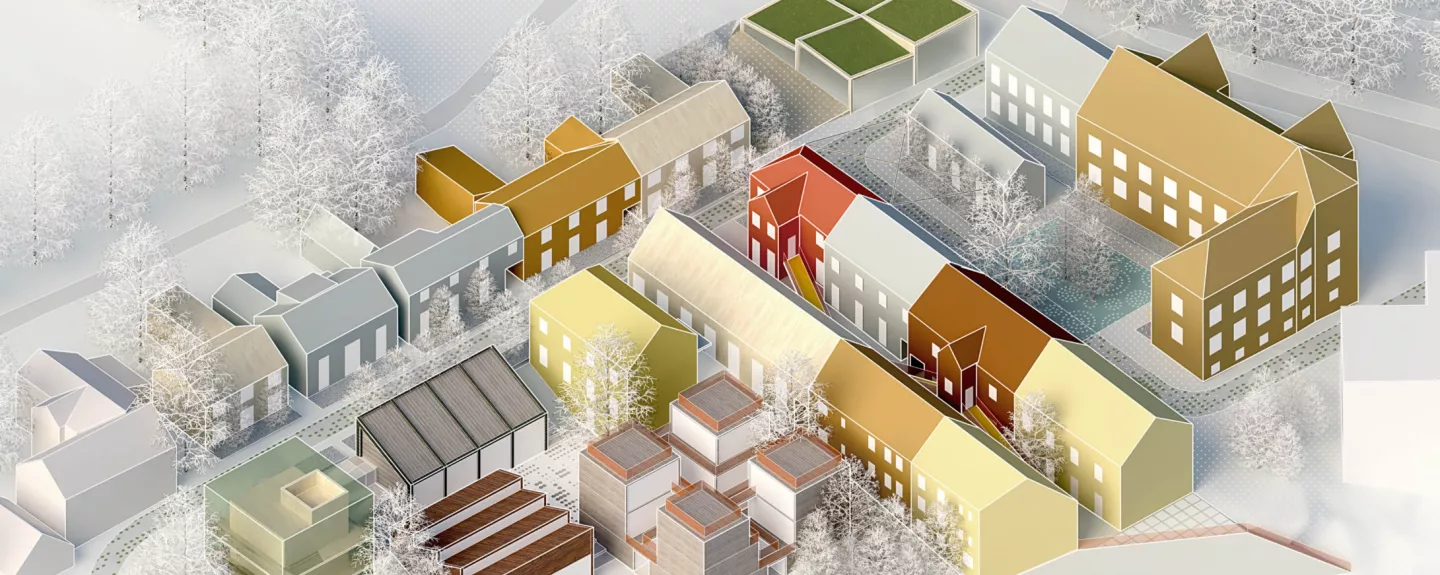
"Circularity Apparatus" by won the competition for making a Living Lab in Grensen.
General Remarks by the jury
The brief asks to formulate a comprehensive concept and process for the transformation of Grensen. While the task is concise, it opens up for considerable interpretation of what a living lab can be, and what programming is best suited for the site and more importantly its historic buildings. At the core of the assignment is the challenge to balance heritage preservation and transformation matched with the right usage. The result is a demanding task that is both architectural and highly strategic.
Considering the brief's emphasis on concept and process, the jury favoured proposals that presented a decisive, systemic approach to Grensen's transformation and established integrity with its heritage features. Furthermore, these projects demonstrated adaptability in various directions. Instead of rigidly adhering to specific forms, successful proposals displayed openness to reworking within the concept. They can be executed in stages.
After the competition, users will be involved. As the programme for the site was not fixed in the competition brief, the jury concluded that successful proposals must demonstrate ample scope to accommodate various functions in the scheme. There must be the possibility to connect either the existing buildings or the proposed new buildings to larger units. The best proposals had the potential to be living labs, testing conservation methods, experimentation in new buildings, combining these two and exploring social programming of various types of spaces.
The jury also appreciated proposals with robust urban qualities. That includes how essential spaces in the proposals connect with the main university building and lawn, how Grensen presents the university to the street, and how the proposal utilises the movement through the site.
While many proposals highlighted the transformative impact of new buildings on Grensen, a few advocated for a radical reconfiguration of existing buildings, thus challenging the paradigms of building conservation. Two of these are among the top projects: the In-between lab and the Gatehouse. The first sketches out a light-touch approach to connect and extend the old buildings, while the latter proposes knocking down walls to unite and enlarge the buildings. The jury saw the In-between lab as a structurally easier and more adaptable concept and therefore as a more flexible starting point for the post-competition process.
The winner, the Circularity apparatus, provides the most flexible process to develop the site gradually. It is less architectural than the other top projects: the Circularity apparatus is a more strategic proposal and can easily be developed in phases. It represents an urban framework that can be divided into various renovation, transformation and infill projects. Should the university require a larger interior space, the Circularity apparatus can be reworked to accommodate it as a new building, without losing its urban qualities. After all, that might prove easier than forcing such space in to the old buildings, which are inherently different. The Circularity apparatus can be combined with elements of the other awarded projects, in particular the elements of working on the shielded in-betweens. The project provides a solid basis to facilitate the programming of the site and developing a scheme for the future living lab.
Download the full report for feedback on all projects
Team
Eugenia Bevz (UA), architectJury remarks
This project stands out among all the proposals because it is a spatial strategy on how to transform Grensen into the living lab the brief demands, rather than being a proposal and a design for one or more set buildings.
This is the future, where buildings are shaped by what is at hand through reuse, either direct or through up-cycling. So the suggested buildings in the proposal are to be seen more as ‘placeholders’ or symbols than actual architectural designs..
The neighbourhood in Grensen becomes a true laboratory for finding new, experimental and sustainable solutions, on all scales. It could be for the whole building, but also for testing materials or specific solutions within a building
The proposal builds on a strong respect for the existing, but also an open-minded wish to look at the existing with fresh eyes – and succeeds in doing both by keeping with the logic of the lay-out of the city-spaces and the scale of the existing buildings, but not being afraid to be very bold when it comes to how new buildings might look.
The streets and squares of the proposed site appear as humanely sized spaces, gaps, between the old and new building volumes. A great variety of different types and sizes of city-spaces comes out of this approach. Especially the transitional zone towards Christian Frederiks Gate is solved really well as a series of small urban ‘niches’ which invites people in to go exploring in the dense new neighborhood behind.
The proposal gives the strongest answer to what a living lab can be by providing a simple structure where a diverse range of experimental projects and processes can be implemented by different university actors. The project provides a degree of flexibility that will allow the living lab to become a truly participatory process between students, researchers and university departments. Some buildings can be experimental design-build projects by students, some objects of research on energy efficiency, while others can be developed in more conventional ways if desired.
Team:
Bachir Benkirane (MA), architect
Megi Davitidze (GE), architect
Jury remarks:
In-between lab draws attention to a characteristic Trondheim typology: the roofed inner courtyards and shielded outer-inner spaces. The illustrations envision a light, beautiful structure barely touching the old wooden houses. While fully respecting the fragile historic environment, the new construction serves a dual purpose, creating a second skin to insulate and protect while simultaneously creating new flexible spaces.
The structure can be read as a greenhouse, but also something more, something new. The contrast between the new and the old is captivating and together with the name In-between lab it raises the idea of a structure, capable of solving energy and climatic challenges, preservation together with adaptation, along with spatial and programmatic considerations. The interpretation goes beyond a mere glasshouse, offering an innovative approach and should be further researched.
In-between lab must also be commended for being one of the few projects that show genuine care for the biodiversity of the site. By placing a larger structure in between the existing buildings in Grensen, they allow for the triangle lot to be left as is, only placing a carefully crafted ramp in between the trees. This “in-between” attitude is present in all the different scales of the project and represents one of the clearest architectural interpretations of the E17 theme of Care.
The project shows an adaptive approach and can easily be combined with the winning proposal. It allows for phased implementation and the testing of new ideas. The proposal goes beyond filling the gaps between existing buildings; the team ingeniously employs the structure to introduce larger indoor spaces and define distinct outdoor areas. Its strong connection to the university park enhances the site's welcoming atmosphere, while the corner plot remains a green escape with minimal interventions, ensuring accessibility while preserving its natural charm. The jury commends the team for its light-touch approach, inviting nature, people and history in.
Team:
George Guida (IT), architect
Tatjana Crossley (GB), architect
Konrad Holtsmark (NO), architect
Bongani Muchemwa (GB), architect
Mina Gohary (GB), student in architecture
Steven Mccloy (GB), architect
Jury Remarks:
The project must be commended for deceptively beautiful illustrations and a radical approach to the transformation of the existing buildings. The Gateway transforms Grensen into one large university building and a covered street that is intended to bring people through and shelter them from the harsh environment. The L-shape is a clever strategic move, that makes the ‘university corridor’ the proposal’s central and connecting element, and generates strong relationships with the context. While it occupies and gives an active role to the back side of the oldest buildings facing the university, it manages to become part of the heterogeneous urban front facing the street.
Nevertheless, the jury found less convincing how the proposal intervenes in the historic buildings, in a way that is pretty unrealistic and would presumably demand a complete reconstruction. There are not only technical but also many philosophical challenges in making such a complete makeover to listed buildings. Although the project claims to work on their existing matter, in reality it ends up erasing a lot of their uniqueness and heterogeneity. In a way it shies away from the 'dirt' of the existing fabric, as the visualisations of the project reveal. But in cleaning it up it seems to be sacrificing much of its valuable genius loci. Its doubtlessly remarkable technical radicality seems to lead precisely to the production of a standard.
The way in which ‘the Gateway’ connects everything together as one large building also challenges some main aspects of the task, such as upgrading Grensen to an inviting urban environment, and allowing for research and experimentation on existing buildings. The proposal, while one of the boldest, risks making Grensen into a large standard university building, and does not give space to the kind of research, experimentation and circularity that the program asks for. A more gentle approach to conserving the existing buildings would have added value to this proposal. It would have given the possibility of using Grensen as a learning laboratory of how to use old valuable buildings as a core of something new.
Regardless of the numerous challenges of the proposal, the jury highly appreciates the project addressing and exploring a typology that is typical to Trondheim; the roofed in-betweens.
